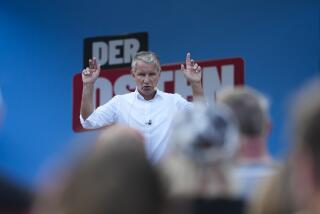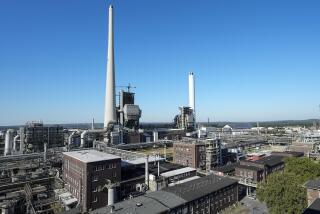A New Divide Challenges Germans a Decade After Reunification
- Share via
GOERLITZ, Germany — In this town that is as far east as you can get and still be in Germany, no one denies that there is still much work to be done in bringing east and west together.
But the divide is not the enduring cultural clash between eastern and western Germans. Rather, it is the prosperity gap with fellow Goerlitzers across the Neisse River in Poland.
Western German money and eastern German muscle have pretty much erased the economic disparities within the country--something that has come as a surprise even to easterners--in the decade since the painful post-World War II division ended in a shower of tears and fireworks Oct. 3, 1990.
Today, say the successful and satisfied eastern inhabitants who are often unheard amid the disruptive few, the challenge of creating a healthy and wealthy Europe involves integrating Eastern Europeans into their own newly discovered land of plenty.
Cheaper labor and goods will flow westward from Poland, Hungary and the Czech Republic if they become European Union members, as they hope, by 2003. The pressures on the still-fledgling good fortune of eastern Germans can already be felt in border towns such as this one, where black-market labor and products are rampant.
That daily influx is partly responsible for the strangling 23% unemployment rate afflicting Goerlitz and instills fear and anger even in many who have jobs.
But focusing on the hardships of the jobless in one of the world’s most generous welfare states misses the point, eastern Germans say. After all, they’ve managed to lift themselves out of the dispiriting ruins left after the East German dictatorship collapsed.
“Our situation is better than we are willing to say it is,” conceded Axel Krueger, whose wine shop on Peterstrasse--a quaint promenade newly restored to its medieval splendor--has found a strong market for his connoisseur’s tipples in this town of 63,000.
“That people are willing to spend money on quality wines isn’t just evidence of a material change but also of a psychological one,” Krueger said. “There is more courage now. No one fears this will all disappear someday.”
At Heidi Klinger’s porcelain painting studio a few blocks away on Neissestrasse, the artist exudes equal confidence that, despite the closure of eastern Germany’s traditional industries such as textiles, mining and machine-building, the economy is on the upswing--and with it the mood of the masses.
The perceptions of the local businesspeople of mounting self-assurance and prosperity are reinforced by measurable improvements in infrastructure such as the new highways, sleek rail lines and airports connecting eastern cities to the west.
And a federal assessment of the achievements of 10 years of unification presented to Parliament last month puts statistical flesh on the skeleton of optimistic impressions.
Living standards in the east have just about caught up with those in what was West Germany, and worker productivity has made giant leaps over the last two years, the federal minister for eastern reconstruction, Rolf Schwanitz, told the Bundestag, the lower house of Parliament, in a formal report on reunification’s progress.
Most important, Schwanitz contended, is that, despite the persistent problem with a depressing 17% average unemployment in the eastern regions, 94% of youths surveyed in the official assessment described their prospects for personal success as positive.
Those indications of recovery contrast sharply with what has become a prevailing image of eastern Germany as a disgruntled wasteland of idle malcontents and neo-Nazis. While social and political leaders express alarm over this past summer’s rash of right-wing violence in the east, they note that the bulk of the unemployed are women and men older than 50 whose skills have proved unsuitable to the more technologically driven new economy.
Jobless in New Economy
The jobless tend to be people like Dagmar Mitscheng, whose textile factory went bankrupt soon after reunification because the workers were outbid for business by lower-wage operations in Asia.
“There are jobs emerging now for young people, especially those with Internet skills. But for anyone like us--over 50--who was trained for a different economic system, the prospects are not good,” said Mitscheng’s husband, Peter, whose training in architectural preservation has, in contrast with his wife, meant more business than he can handle. “The only way the long-term unemployed problem is going to ease is with time, as the young become a bigger proportion of the work force.”
Much of the activity in Goerlitz evolves around reconstruction, with improvements underway or planned for most of the 3,500 buildings in the Old Town. But the federal progress report on eastern recovery also provided the encouraging news that manufacturing jobs now outnumber those in construction for the first time since the post-reunification building boom began.
Georg Rittmansperger came here eight years ago from Bremen when his father’s real estate development firm bought a row of 500-year-old buildings in Goerlitz’s Old Town. The firm has since moved on to other projects, but Rittmansperger, 25, has staked his fortune on construction here and built a subsidiary of the family business with the help of local friends.
The Poland Factor
Although he is a classic example of the well-heeled westerner tapping into the east’s delayed promise, the young developer contends that there are no frictions, social or otherwise, with easterners of his generation.
“We don’t think in cliches, like this one is a Wessi [westerner] and that one is an Ossi [easterner],” said the entrepreneur, who, like his eastern partners, has no memory or experience of Communist-era tensions.
Part of this town’s continuing struggle with unity is due to the proximity of cheaper goods just across the river in Poland. Residents, especially those on unemployment benefits--which are generous by most standards at more than 70% of a worker’s last wages--tend to buy their groceries and gasoline across the border where the tax bite is easier. That, however, means lost sales for Goerlitz merchants and less tax revenue for jobs in the public sector.
Towns this far east also tend to suffer from their position on the far edge of Europe, but the optimists see EU expansion as more likely to be a solution than an intensification of the problem.
“Investors don’t want to come here now because they think it’s too far from the more established centers like Leipzig and Dresden,” Mayor Rolf Karbaum said. “But once the EU reaches all the way across Eastern Europe, we will actually be in the heart of the continent and well-positioned to function as a crossroads because of our experience living on the border.”
Goerlitz was divided after the Nazi defeat in 1945, and the eastern homes, industries and farmland were made part of Poland. EU expansion will likely transform the divided halves--Goerlitz and Zgorzelec--into a model of multicultural cooperation.
With its predisposition for cross-border contacts, Goerlitz has been designated by EU officials in Brussels for special projects in the run-up to expansion. That has qualified the town for integration funds for improvements such as a second bridge across the Neisse to restore traffic flow through the Old Town.
Still, Goerlitz officials complain that state funds for boosting the attractiveness of Saxony state towns for private investors are too concentrated on the prosperous trio of Dresden, Leipzig and Chemnitz.
But economic planners in the Saxon capital, Dresden, defend their strategy of building up the biggest urban centers first.
“We hear this complaint a lot about the big cities being favored, but we have done this intentionally,” said the state’s economics minister, Wolfgang Vehse. “You need an airport and regionally based services to draw major players here, and they hopefully pull in more new enterprises when their operations prove successful. I don’t think we would have this ripple effect into the less-populated regions if we just divided up the government funds for infrastructure and spread them around evenly.”
The trickle-out approach has shown some rewards, with investments such as Toyota’s opening of its TDDK operation in the village of Strassgraebchen to build automobile air-conditioning equipment for the continent’s thriving car makers.
Likely because of its comparative success in luring new industries and jobs, Saxony has been spared most of the ugly right-wing rampages that have marred the image of other eastern German states such as Brandenburg, Thuringia and Saxony-Anhalt.
TDDK’s president, Nobuyuki Araki, said the six Japanese families who have settled in Strassgraebchen since April have encountered only cordiality among their German neighbors.
“People understand that business is international and joint ventures like this one are good for everyone involved,” Araki said.
Whether Poles and other Eastern Europeans seeking jobs instead of bringing them into an expanded EU will be received with equal hospitality is another question, but one that most in eastern Germany believe they are coming to grips with.
“There is no alternative to further integration. This is what the future consists of,” said Marie-Luise Beck, Germany’s federal commissioner for foreigners. “We have to learn how to live with immigration and diversity because this is what the aim of European unity is all about.”
More to Read
Sign up for Essential California
The most important California stories and recommendations in your inbox every morning.
You may occasionally receive promotional content from the Los Angeles Times.











